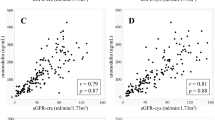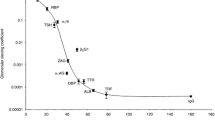Abstract
Tamm-Horsfall protein (THP) has been found in the renal interstitium in patients with obstructive uropathy. The aim of this study was to investigate whether serum concentrations of THP could serve as a screening test for urinary tract obstruction. The presence of THP in normal human serum was confirmed by sodium dodecyl sulphate polyacrylamide gel electrophoresis and Western blotting. A specific enzyme immunoassay was then used to measure the serum concentration of THP. Serum THP concentrations were estimated in a cross-sectional study of a group of 23 patients who had technetium-99m-diethylenetriaminepenta-acetic acid (DTPA) nuclear urinary excretion studies to define urinary tract obstruction, and in longitudinal studies in 2 patients who developed acute bilateral ureteric obstruction following operations for ureteric reimplantation. The subjects with DTPA-proven urinary tract obstruction had higher concentrations of serum THP (n=10, median = 43.9 ng/ml, range 10.4–152.1 ng/ml) than those who did not have obstruction (n=13, median = 9.6 ng/ml, range 1.26–61.9 ng/ml). While this difference was significant (P<0.01, Mann-Whitney U test), 6 of the 10 patients with obstruction had serum THP concentrations within the range of those patients without obstruction. The patients who developed acute bilateral ureteric obstruction both had increases in serum THP concentrations with obstruction and decreases in serum THP concentrations following relief of obstruction. These changes paralleled those in serum creatinine. The studies indicate that urinary tract obstruction results in increases in serum THP concentrations but these changes are not sufficient in magnitude to allow screening of children for urinary tract obstruction.
Similar content being viewed by others
References
Hoyer JR, Sisson SP, Vernier RL (1979) Tamm-Horsfall glycoprotein. Ultrastructural immunoperoxidase localization in the rat kidney. Lab Invest 41:168–173
Lynn K (1982) Tamm-Horsfall glycoprotein-what relevance to health and disease? NZ Med J 95:457–458
Avis PGJ (1977) The development of a radioimmunoassay procedure for the estimation of Tamm-Horsfall glycoprotein in human serum. Clin Sci Mol Med 52:183–191
Resnick JS, Sisson S, Vernier RL (1978) Tamm-Horsfall protein, abnormal localization in renal disease. Lab Invest 38:550–555
Zager RA, Contran RS, Hoyer JR (1978) Pathologic localization of Tamm-Horsfall protein in interstitial deposits in renal disease. Lab Invest 38:52–57
Bhagavan BS, Wenk RE, Dutta D (1979) Pathways of urinary backflow in obstructive uropathy. Hum Pathol 10:669–683
Gates GF (1982) Glomerular filtration rate: estimation from fractional renal accumulation of Tc-99m DTPA (stannous). AJR 138:565–570
Tamm I, Horsfall FL (1952) A mucoprotein derived from human urine which reacts with influenza, mumps, and Newcastle disease viruses. J Exp Med 95:71–97
Laemmli UK (1970) Cleavage of structural proteins during the assembly of the head of the bacteriophage T4. Nature 227: 680–683
Dresser DW (1986) Immunisation of experimental animals. In: Weir DM (ed) Handbook of experimental immunology, vol 1, 4th edn. Blackwell, Oxford, p 8.1
Ouchterlony O, Nilsson LA (1986) Immunodiffusion and immunoelectrophoresis. In: Weir DM (ed) Handbook of experimental immunology, 4th edn. Blackwell, Oxford, p 32.1
Jones CL, Georgiou GM, Fowler KJ, Wajngarten PI, Roberton DM (1987) Purification of polymeric immunoglobulin from cell culture supernatant by affinity chromatography using secretory components. J Immunol Methods 104:237–243
Burnette WN (1981) “Western blotting”: electrophoretic transfer of proteins from sodium dodecyl sulphate-polyacrylamide gels to unmodified nitrocellulose and radiographic detection with antibody and radio-iodinated protein A. Anal Biochem 112:195–203
Dawnay ABStJ, McLean C, Cattell WR (1980) The development of a radioimmunoassay for Tamm-Horsfall glycoprotein in serum. Biochem J 185:679–687
Yamamoto T, Miyata H, Fujiyam T, Kinoshita T, Maki S (1991) Serum Tamm-Horsfall glycoprotein level in children with various renal diseases. Nephron 59:440–444
Hanson LA, Fasth A, Jodal U (1976) Autoantibodies to Tamm-Horsfall protein, a tool for diagnosing the level of urinary tract obstruction. Lancet 1:226–228
Fasth A, Hanson LA, Jodal U, Peterson H (1979) Autoantibodies to Tamm-Horsfall protein associated with urinary-tract infection in girls. J Pediatr 95:54–60
Avis PGJ (1984) Autoantibodies to Tamm-Horsfall glycoprotein-an artefact of technique? Contrib Nephrol 39:305–315
Alfaham M, Peters TJ, Meyrick S, Avis P, Verrier Jones K (1989) Serum Tamm-Horsfall protein levels in childhood: relationship with age and glomerular filtration rate. Nephron 52:216–221
Storch S, Saggi S, Megyesi J, Price PM, Safirstein R (1992) Ureteral obstruction decreases renal prepro-epidermal growth factor and Tamm-Horsfall protein expression. Kidney Int 42: 89–94
Author information
Authors and Affiliations
Rights and permissions
About this article
Cite this article
Johnstone, L.M., Jones, C.L., Walker, R.G. et al. Tamm-Horsfall protein: are serum levels a marker for urinary tract obstruction?. Pediatr Nephrol 8, 689–693 (1994). https://doi.org/10.1007/BF00869091
Received:
Revised:
Accepted:
Issue Date:
DOI: https://doi.org/10.1007/BF00869091




